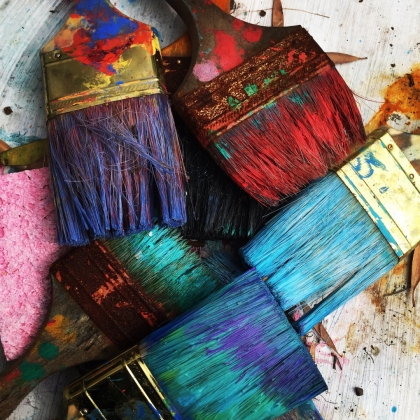
By: Rima Koleilat
I'm forever salvaging distressed brushes in my classes. Sad, flayed and bloated from the murky container that once contained clear water or left to dry on the table, forlorn and caked with paint.
But it really doesn't take a whole lot to keep your brushes happy and extend their life. Just give them a little TLC and they'll be forever grateful. Promise.
This applies to water-based mediums, such as watercolour, gouache, acrylic paint and ink.
1. Quick Clean to Reuse
Don't drown your brush! Leaving your brushes to soak up water while you're continuing to paint is possibly the worst thing you can do to them.
If you want to clean and use your brush again right away, remove excess paint with a paper towel first (sometimes a dry clean is all you need to do).
For a more thorough clean, swirl your brush in a container filled with water to get rid of the remaining paint.
This bears repeating: do NOT stand your brush in the water container.
Blot gently on a lint-free towel or paper towel and carry on.
2. Clean and Store
Once your painting session is done, always take the time to clean your brushes thoroughly, right away, and dry them carefully. You don't want to end up with crusty, sad brushes that need CPR to come back to life (more on that below).
No need to run out and buy expensive brush cleaning potions – these do a nice job but all you really need is a gentle liquid dish soap to adequately clean your brushes. Organic bar soaps work fine too but I prefer liquid soap.
Add a few drops of liquid soap to a small container filled with lukewarm or cold water and swish to mix. Never hot water though, that’s really bad for the brush.
Blot away any remaining paint on your brush then dip in the soapy water. Clean the brush by running it back and forth on the sides and bottom of the container.
If extra help is needed to get every bit of paint out, I find that a spiky plastic brush cleaner disk like the one below left gets all the paint out. A silicone make-up brush sponge works well too. In my home studio, my favourite is a round silicone dish brush.
| Spiky Plastic Brush Cleaner | Silicone Makeup Brush | Silicone Dish Brush |
3. Brush CPR
Sometimes brushes end up laminated with dried paint. It happens. Even to me… more often than I care to admit. No need to panic, I have the perfect remedy and a secret weapon – guaranteed to work every time, without too much effort or toxic chemicals.
My secret weapon is … plain old hand sanitizer. Here's how it works:
Place a dollop of sanitizer (plain, unscented, no beads) on a small plate or a folded paper towel or the sink.
Rub the brush on the plate so the sanitizer really gets into the bristles and starts to break down the dried-up paint.
Keep rubbing the brush with the sanitizer until you feel that there aren't any stiffened bristles.
For really bad cases (e.g. dried up medium), the plastic cleaning disk pictured above works wonders in combination with the hand sanitizer.
Rinse well. Clean with soap and water as outlined in No. 2.
4. Drying and Shaping
Air dry brushes by laying them flat on a lint-free towel (paper or cloth).
You may need to reshape your round brushes (the ones that taper off) by gently squeezing the bristles to form a point.
Do not stand them up when they're still wet – the moisture will seep into the ferrule (the metal part that holds the bristles tight) and the handle and ruin them. You may have seen brushes where the lacquer on the wooden handle is cracked and flaking – that's because it stood in the water for too long. Brushes with wooden handles suffer the most by standing them upright while still wet, but this is true for brushes with human-made materials as well.

 Visual Arts Brampton
Visual Arts Brampton